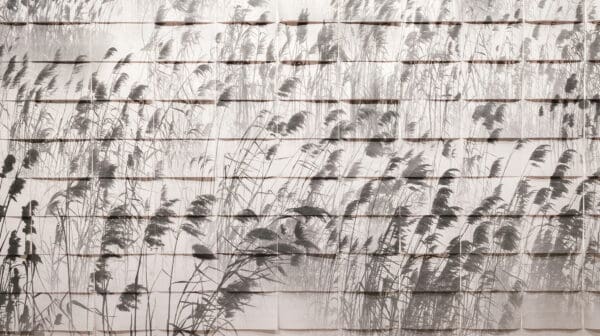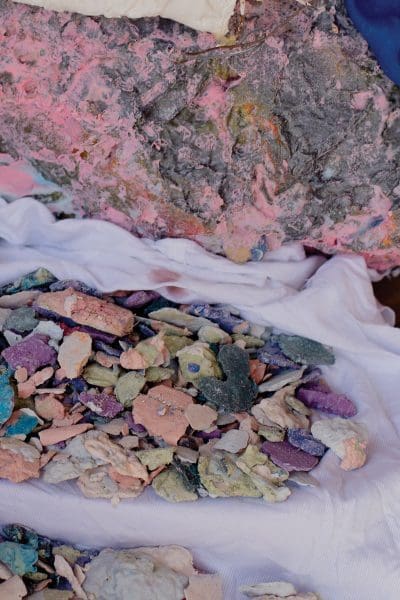
Poetics of Relation
Tender Comrade, currently on show at Sydney’s White Rabbit Gallery, creates a new vocabulary of queer kinship by reimagining the relationship between artworks, bodies and space.
Nabilah Nordin’s sculptures are joyously textured and always surprising. Often teetering on the verge of falling, their surfaces beg for a closer look, variously revealing feathers, macaroni, papier-mâché or cement encrusted in paint. They ooze and clot; they are both abject and alluring.
Nordin’s home studio in Melbourne is a space where living, making, eating and exhibiting coalesce in a glorious blur. She tells us about throwing sculptural dinner parties, playing with food, and how to build giant artworks in a small space.

Place
Nabilah Nordin: At the moment, my partner Nick [Modrzewski] and I are living in Newport—we just moved in two weeks ago. Before that we had our studio right at the back of our house; it was an open space that was all covered like a greenhouse. It was enough space to make large sculptures but there’s never enough space. Because we’re transitioning now, I’m in a smaller studio. It’s good because I can still continue working, but it’s just tricky making larger works.
We are actually going to build a studio in our back yard. We’re in the process of designing what our studio is going to be like: for me, it’s really important to have a lot of ventilation and air flow because of all the materials that I use. But then it would also need a wig room and a costume room and a room full of recycled objects. Then we’ll need a cement truck with a hose that spurts out cement and industrial blenders to mix things up. And a huge wall of Nick’s sculptural heads. But in reality it will probably just be a simple A-frame structure at this stage.
The studio that we’re going to build is probably not going to be our ‘dream’ studio, but I think my dream studio would be, like, a never-ending storage space.
Right now I’m working on three large sculptures. One of the sculptures is going to be 4.3 metres high, so I’m building it outside and storing it inside in case it rains. I have to be really practical—it’s built in components, so it’s stackable, and I can take it apart and put it back together again.

Process
Nabilah Nordin: When you make one thing, your next step is going to respond to the last thing that you did. I know that I have to start with an armature, so it’s like, “How do I create something that stands, or that will look like it’s toppling?”
I really see it as two different parts: the first is the structural component and how to get things looking like they’re up and solid. And then the second part is about extending or expanding the form and thinking about the finish of it. I think a lot of the intuition that happens, happens at the beginning—because once the structure’s there, there’s only so much you can extend out to.
I use a lot of construction and building materials, but I’ve recently started using things like resins and fabrics. And I’ll always use found objects, but I’ve started to reveal some of the found objects in my works, like the wooden spoons. There’s chicken wire, there’s a lot of wood; I do welding with steel, and different reinforcement bars. I use lots of stuffing, so pillow stuffing or plastic bags; I use a lot of wire for wrapping things, and that’s my kind of reinforcement of my work, using a lot of wire.
And then the way I finish it is usually I use a lot of plaster or paper pulp or cement, depending on where it’s going. Recently I’ve been cutting up feathers and mixing it with a lot of PVA glue to create paste. You can cut up anything and put it in PVA glue, and then it’ll go hard. I’ve done stuff with Play-Doh, like putting Play-Doh in glue; cutting up confetti or old balloons, things from party shops. So there’s a whole mix of different materials.

Projects
Nabilah Nordin: During 2020 the home space started to become a huge thing for me—well, for everyone, but I was really inspired actually. I was lucky to be in a position where I could try new sculptural mediums and experiment with new projects.
I had an exhibition called Sculpture House, where I basically made a lot of work in my studio and displayed it around the home—in the kitchen and in the bathroom and the very small laundry space, the whole house. People would call and book in appointments, and come through the house and have a look at my recent works. It was nice because it was like an open studio and an exhibition space and a home space; everything kind of intermingled in a really lovely way, where you could meet new people and not be in a pressured environment.
And then I wanted to do stuff with cooking, with food—like, food being this extended materiality into my sculpture-making. It was like, “How do I make food the way I make my construction building materials? How do I make it oozy, or rough?” Food has so many different qualities and colours and textures to it—it’s a whole new world. Once I started, I was like, “This is amazing, I don’t think I can ever stop now. I need to keep playing with food!”
So then I was like, “Oh, I’m cooking all this food—now I’ve got to get people to eat it.” I started to think about food more in an installation setting. So I made a whole spread of different sculptures and food. With my friend Sophie Prince, a curator, I started to work on a project called Please Do Not Eat the Sculptures. Once every month we invited three artists that we didn’t necessarily know, or they didn’t know each other, over to my place for dinner amongst the sculptures, and the food that I would cook.
It was quite a lot of work, because every month I had to set up this huge sculptural installation in the front room. And we didn’t know how it would play out, you know, every dinner! But it was just meeting and connecting with artists again after being isolated for a long time—so it was so special to do that.
Prop Shop
Nabilah Nordin
Neon Parc (Brunswick)
25 June – 23 July
This article was originally published in the September/October 2021 print edition of Art Guide Australia.